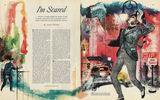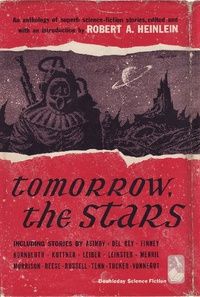SPOILERS

| Added | Mon, 16/10/2017 |
| Release date | 1951
|
| Original title | I'm Scared
|
| Феномены | |
| References | Сборник Англо-американская фантастика М.: Скорина, 1992 г.
|
Jack Finney's short story "I'm Afraid" (or simply "I'm Afraid ..." translated by O. Bitov) was first published in the September 15, 1951 issue of Collier's Weekly, and then, in 1952, was included in the anthology of science fiction works under the direction of Robert Heinlein "Tomorrow, The Stars".
Interestingly, the part of this story concerning the case of Rudolf Fenz was accepted by paranormal researchers as a true story of time travel.
The part of Jack Finney's story "I'm Afraid" (or simply "I'm afraid..." translated by O. Bitov, 1951), concerning the case of Rudolf Fenz, was accepted by paranormal researchers as a true story of time travel.
The story is told in the first person. It begins with the fact that the main character describes one of his evenings when he caught a half-century-old broadcast on the radio, and this event became the beginning of his hobby. He decided to collect unexplained facts about time chronoclasm (English chronoclasm - in science fiction one of the possible consequences of time travel).
The program, which accidentally broke into the air, was interrupted completely suddenly:
The radio went silent. For a moment there was no sound, just a faint hum. And then a completely different program began: Bing Crosby's performance with his son, the last bars of "Sam's Song", which I love very much.
The main character remembers that the host of the program he just heard died a long time ago. Apparently, the broadcasts in the recording were very rare at that time, because it surprised him very much. While sharing this story with his friend, he heard another strange story in response. Louis Trachnor (a forty-four-year-old coal and wood merchant living near Danbury, Connecticut) noticed a bright streak of paint on the facade of his house in the morning. He cleaned it and painted it over, but it appeared again. From which the hero concluded that this is some kind of chronoanomalia:
Let's further assume that no one touched Mr. Trekner's house except himself: he painted his house in October, but due to some fantastic confusion in time, a bit of new paint appeared on the facade last summer. Since then, in the summer, he cleaned off this paint, the strip of fresh gray disappeared after he repainted his house in the fall.
Then there are mentions of other strange cases: a check registered a day earlier than it was signed, and a letter that was dropped into the mailbox seventeen minutes before delivery.
The next big case that was described in the story is the story of an office employee from New York, Julia Eisenberg. A dog got attached to her on the street, which for three days faithfully waited for her at the entrance, and then disappeared. A few years later, she was given a puppy, which then grew up and ran away from home. Later, the woman realized that it was the same dog:
Nonsense or not, my dog got lost-I drove him away myself-two years before he was born...
The next case described in the story concerned a certain Paul V. Kerch, an accountant from the Bronx. He, being an amateur photographer, took several pictures of himself and his family in the park. Two similar photos taken on the same day depicted different seasons (autumn and spring), different women (wife and stranger), as well as different costumes on the head of the family and his son:
He handed me the picture. For a moment I thought it was another print, exactly the same as the others; then I noticed the difference. Mr. Kerch was the same as before, bare-haired, with a wide grin, but he was wearing a completely different suit. The boy standing next to his father had grown a good three inches, his pants were long, it was clear that he had grown older, but it was no less clear that this was the same boy. But the woman had absolutely nothing in common with Mrs. Kerch. Elegant blonde - the sun shone in her fluffy hair-pretty, just can't take your eyes off. She was smiling, looking straight into the camera, and holding Mr. Kerch's hand.
[...]
- And the trees are in bloom! I said. Behind the boy, full of importance, grinning Mr. Kerch and the woman with her beaming smile were the trees of Central Park, dressed in thick summer foliage.
Then there is another small case from Lieutenant Alfred Eichler (Alfred Eichler) from the police station in New York. He tells the main character about his two investigations, which involve the same weapon (which is confirmed by ballistic examination), which was in a locked safe at the police station during the second murder.
The last case in the story is from a retired employee of the New York Police Department Hubert Rome (Captain Hubert V. Rihm). He told about one case from his practice, which began in June 1950. Then he was having coffee with one of the interns when the body of a certain young guy in funny clothes and with sideburns was brought to him:
The captain said: "Have you ever known anyone who would wear such tight trousers with big black and white checks?"
I needed to think. "Yes, I said then, my father, when he was a very young man, before he got married. I've seen old photos."
"Of course," Captain Rome said, and he probably wore a short jacket with two fabric buttons on the back, a vest with lapels, a tall silk hat and a big black tie over a stiff collar. So how is this person dressed? Like seventy-five years ago! And he can't be more than thirty years old. In his hat is the label of a clothing store on twenty-third Street, which went out of business at the turn of the century. What conclusion do you draw from this?"
The police were also very surprised by the items found in the pockets of the guy during the search: a 5-cent beer token with the name of an unknown bar; a bill for washing the carriage issued by a non-existent stable on Lexington Avenue at that time; about $ 70 in old banknotes; a business card with the name of Rudolf Fentz, on which his residential address on Fifth Avenue was listed in New York, and a letter sent to the same address in June 1876 from Philadelphia. But the address indicated in the business card could not be the place of residence, since there had been a store in this place for many years. There was no such name in the phone book, and there were no prints of the strange man in the police database.
No one saw how this strange guy ended up in the middle of the roadway, but witnesses claimed that he looked back at the signs with fear in his eyes when he was hit by a car.
Just before his retirement, Rome found a missing persons file for 1876 in old police reports, and Rudolf Fentz was included in this list. However, there was no photograph, no fingerprints, nothing that would help to make an unambiguous conclusion that it was the same person.
At this point, the author stops describing cases and starts thinking about the causes of such anomalies through the reasoning of the protagonist. As a result, he comes to the conclusion that modern people dream of escaping from today's reality, and nature (or the universe, or something else) it helps them in such a strange way.
It is worth noting that the last two cases, told on behalf of the police department, are not in the Russian version of the story.
Phenomena in artwork: Chronoanomalia
The story describes several incidents of chronorally. However, the author describes them as unobtrusive and transparent, which creates a feeling of reality. There are no colorful descriptions of time travel, and only hints at the strangeness of what is happening. Not surprisingly, one of the cases took to be real. It is strange that not all.
Let us examine in order:
Old gear. This case can be easily explained archival record, fired into the air by mistake in the Studio, or random RF interference, whateva from the second frequency. However, the protagonist is this something abnormal.
The case band on the facade. Initially the injured merchant, coal and firewood assumed that this simple hooliganism. And it could easily remain so if the main character does not put it in parallel with my case.
Dog Yulia. The woman decided that the dog who was waiting for her on the street and her grown-up puppy is one and the same being. She had no proof of this, besides internal sensations.
Photo from the future. The accountant received on the film a photograph with her son and an unknown blonde woman, claimed not to know the girl and didn't do such a photo. His wife suggests that this future wife a grief-the photographer. There is no even hint that the picture was taken with the mistress of the accountant, not next spring, but held. Although this idea arises from the reader itself.
The gun in the safe. Here is the description of the murder made pistol that was found at the crime scene a day earlier and was locked in a police safe. Again, quite a small case, which can be explained by the error of examination or a killer COP.
A traveler from 1876 Rudolph Fentz. Described an accident with person who can be identified as lived for 75 years before the events described. The author describes not talking to him, but only the identification and conclusions on circumstantial evidence.
Such descriptions of abnormal cases is very similar with real eyewitnesses, so it is easily perceived by the reader as real. The story describes situations that can occur in a person's life, thus bringing fiction to reality, forcing you to think and even to believe it.
Translated by «Yandex.Translator»
Log in or register to post comments




